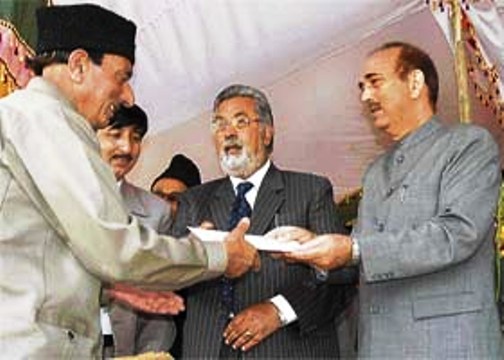
Conceived by Abdul Rahim Rather to light up the state and its resources, the Roshni Scheme had a darkened delivery by Ghulam Nabi Azad. In a bid to become Sheikh Abdullah-II, Azad created the mother of all swindles in the name of reform and resource mobilisation. R S GULL traces the scheme’s role reversal history
Last week in the Assembly when finance minister Abdul Rahim Rather talked about the changes his predecessors effected in Roshni Scheme, his body language did not match the requiem of an innovative scheme he had conceived. Apparently, compulsions of coalition prevented him from detailing the disaster that Congress brought in by defusing Roshni for vote politics. “The original Roshni Act {J&K State Land (Vesting of ownership to the occupants) Act 2001} was targeted to raise revenue of Rs. 25,000 crores that were supposed to be deposited in a special fund for power generation in the state,” Rather told the House. “Due to amendments in 2004 and 2006 by the previous governments, free ownership rights were conferred to the occupants on a vast chunk of land due to which the targeted revenue under the scheme could not be achieved”.
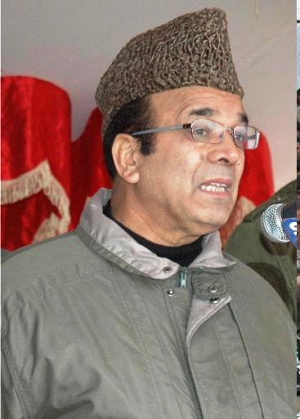
Roshni, despite being innovative, was a racket from day one. As subsequent rulers tried to milk it for electoral gains, it emerged as the mother of all the state patronized swindles ever. So far the revenue raised by the scheme stand at paltry Rs. 55.11 crores. Most people in the civil secretariat know it will barely cross a Rs. 200 crore mark. State Vigilance Organization (SVO) has already registered a case involving a number of officers. Insiders in the government suggest it to be a tip of an iceberg.
After National Conference (NC) came to power in 1996, it started facing music for its failure for not harvesting vast hydropower resources of the state. In a huff Dr Abdullah started executing the Baglihar project lacking financial closure and part of the state equity. He wanted to take up more projects for which he even identified various consortiums abroad. With coffers empty and New Delhi unwilling to offer sovereign guarantees, there was no way forward.
It was at this juncture that Rather came up with the idea of selling the state land at market rates to the people who have encroached it over the years. Proceeds from this would go to Roshni Fund that would fetch the state equity for funding power projects. Legislation was passed in 2001 but well before the rules would be framed, NC was out of power. People in authorised or unauthorised possession of state land from January 1, 1990 were eligible to avail the scheme and get ownership after paying at market rates.
Mufti Sayeed led government largely slept over the issue. He did however ask officials to proceed. Finally it was discovered that rules were not framed as babus face a stumbling block in cases involving residential structures. Changes were effected, rules were framed by Muzaffar Hussain Baig and the act came into force in May 2004. A four-member rate-fixing committee led by top most revenue officers (Divisional Commissioner) at provincial level in Jammu and Srinagar, under the law, was tasked to approve the cases after negotiations and submit the case to the government for orders.
The aggrieved could approach the Chief Minister, the final appellant authority for the scheme, who had to issue his verdict with 30 days. Implementation, however, remained a crucial problem.
In November 2005 Ghulam Nabi Azad took over as the chief minister. Exactly a year after assuming office, Azad issued a circular that marked the beginning of undoing Roshni.
Under the new rules his ‘kitchen cabinet’ framed, encroachers owning residential structures on state or Nazool land would have to pay only 25 percent of the market price. For commercial areas they will have to deposit 30 percent and for agricultural land it was 15 percent.
From political parties and charitable institutions it sought 25 percent of the market value. Over and above, the scheme was loaded with ‘rewards’ and ‘penalties’: a rebate of two to 25 percent for people who make the payments within three months to one year and a similar penalty for those not doing the same.
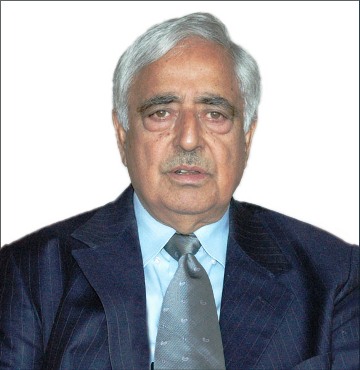
A month later, there were second thoughts. The scheme was quickly reviewed, this time in formal cabinet, and Azad was out to address the press. Under the new rules, a farming family can have total land to the tune of 12.50 acres (100 Kanals) that could include more than two-third of the state land. He reduced the costs to be realized to barely 10 percent, a discount of more than 90 percent. A number of encroacher categories were excluded from the scheme.
Second thoughts were not enough. Roshni’s fate was sealed on February 9, 2007 when Azad reintroduced the scheme in legislature as a “revolutionary step” after Sheikh Abdullah’s historic and path-breaking land-to-tiller settlement. The amended law that earlier sought barely ten percent of the costs from the encroachers now gave them free. They would have to pay a nominal fee of Rs. 100 per kanal for getting mutation in their favour in the revenue records.
“Agriculture is the backbone of state’s economy. Unless farming community is socially and economically well-off, boosting farm produce to cater to the requirements of the state is not possible”, Azad told the House. The new law changed the fundamentals of the scheme by shifting the use (of proceeds) from power to development.
His government put the encroached land that would go to the farmers at 16.60 lakh kanals (207500 acres) with a market price tag of Rs. 15,000 crores. Around three-fourth of it falls in Jammu region. After Azad rejected its ally PDP’s suggestion to send it to select committee, the latter silently supported the move. So did NC by remaining silent perhaps fearing a backlash from peasantry if they protested. The government came up with strange justifications. One claim said that it would benefit 19 lakh cultivators, not knowing that J&K has less than 16 lakh and quite a few of them (16.27 percent) had encroached upon state land. Most of them were from Jammu.
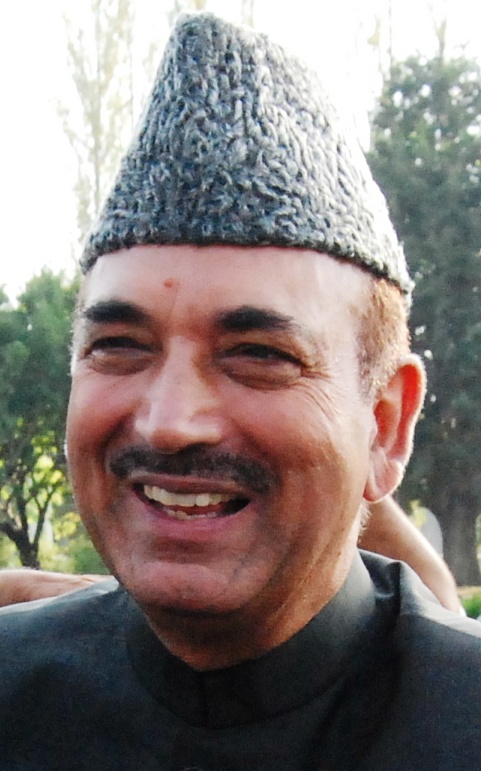
It did not take much time to understand the “revolutionary step” was pro-land grabbers, with members in the cabinet as well as the bureaucracy.
Barely a few days later, Shiv Sena leader Anan Sharma accused Congress minister Taj Mohi-ud-Din of having encroached 342 kanals (42.75 acres) in Raipur and Satwari on outskirts of Jammu city, barely days ahead of Azad’s announcement. Sharma alleged Taj distributed it amongst his three daughters – 100 kanals each.
A Public Interest Litigation even accused Azad of land grab. It is still pending disposal.
“As the announcement of the land being given almost free was made without any formal verification in anticipation, we were sure that influential, moneyed and the powerful would have got revenue records prepared retrospectively and even made fresh encroachments,” a senior officer in the government wishing anonymity said.
Last week after months of investigations, the SVO registered a formal case against eight officers including former divisional commissioner Mehboob Iqbal. They are accused of making retrospective entries in revenue records -in league with some business families- certifying the encroaching claims over a vast piece of land in Gulmarg that had already been earmarked under the town’s master plan.
Interestingly, one of the whistleblowers Dr Farooq Ahmad Lone also stands booked. “We have lodged an FIR on basis of our investigations. We are investigating further,” a State Vigilance Officer said. “A dozen business families are involved so far.”
There would be many rackets involved with Roshni but nobody in government’s policy making coterie cared two hoots about the larger implications. Some analysts allege that New Delhi was instrumental in defeating the scheme that was meant to make the state self sufficient in power.
J&K is one of India’s few states with lowest operational holding size. As per states agricultural census, the average land holding nosedived from 0.76 hectors in 1995-96 to 0.66 hectors in 2000-01. The surveys offer a grim picture. There were 13,35,770 land holdings with an average of 0.76 hectors in 1995 and within five years the number of holdings increased to 14,18,000 while the holding shrunk to 0.66 hectors. Compared to total household population, it indicates that 133768 households are already landless. In fact 2001 census puts the number of houseless population at 12751. The Roshni would create landed and landless population with a huge difference in between. It has already conveyed that even law would support the law-breaker.
A section of officers genuinely admit that Roshni would hamper overall development. Since most of the centrally sponsored schemes for roads and other social sector infrastructure come without any land compensation component, J&K has the poorest performance under Bharat Nirman, especially in the roads. In certain cases, various central ministries have rejected funding the land costs required for various projects citing exorbitant costs. “The state land would have been our land bank to barter with the land that we would require for development but we have given it in charity,” A senior officer who held key position in Azad’s administration told Kashmir Life.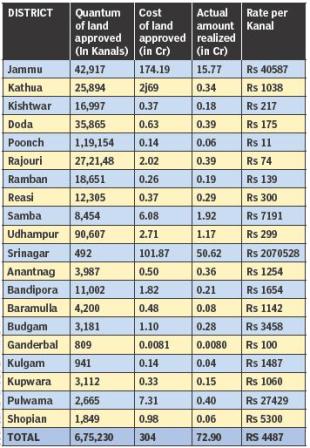
Despite all this, there is nothing to be celebrated about. On March 9, Rather told the House the government has so far raised only Rs. 55.11 crores – Rs. 15.47 crore from Jammu and Rs. 39.64 crore from Kashmir. The statement gives Roshni yet another twist.
The government has received a total of 2,00,659 applications for vesting of ownership on state land – 1,49,786 from Jammu and only 50,873 from Kashmir. By now they have disposed off 1,08,927 and 11,312 applications from Jammu and Kashmir provinces respectively. Some 40,859 applications from Jammu and 39,561 from Kashmir are pending disposal. The land allotted so far under the scheme is 31,103 kanals in Kashmir and 1,77,395 kanals in Jammu.
Zahoor Ahmad, a state government employee is surprised by the provincial anomaly, “How could state government make Rs. 39.64 crores from Kashmir by regularizing only 31,103 kanals and only Rs. 15.47 crores in Jammu where it regularized 1,77,395 kanals?” He says if there were lesser cases of encroachment on state land in Kashmir, is there is a state policy to punish the valley. Any answers?















